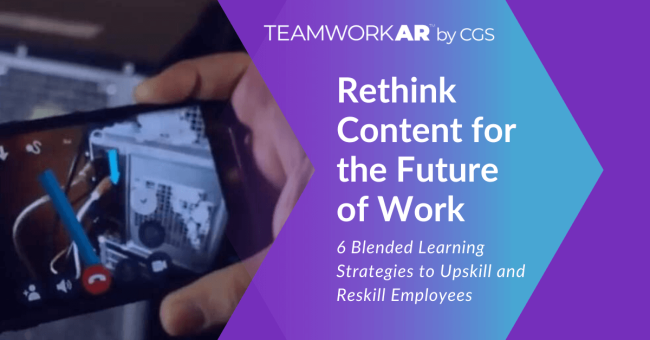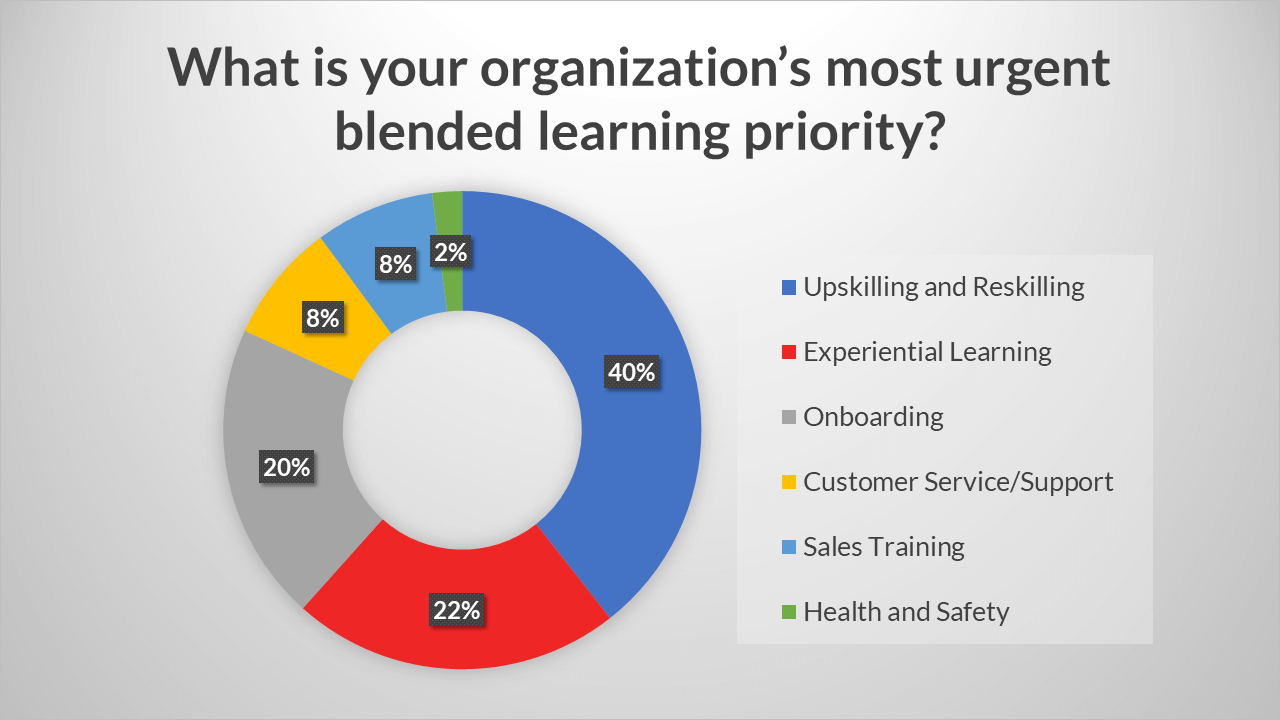Topics
3 Blended Learning Approaches to Upskill and Reskill Employees

Rethink Your Content for the Future of Work
This blog is part 2 of a two-part series. Read Part 1 now for more blended learning approaches.
The disruptions of the past year-plus have forced companies to rethink how they do business. In many cases, conducting ‘business as usual’ required a great deal of pivoting behaviors and priorities.
As these changes developed, L&D employees adapted to a new way of working, while also supporting staff who had to make sudden changes, sometimes in a week or less, in how they collaborate, interact and learn. The situation is thankfully improving for many countries, but many of the innovations and technologies we embraced to get us through will stick around.
Over the past year, companies that used blended learning saw greater agility and success in learning, which in turn improves nearly every other aspect of a business’s performance. In a recent webinar, our Enterprise Learning leader Doug Stephen offered insights and real-world examples of blended learning in action that have helped, and will continue to help, companies thrive.
First, a definition. Blended learning is simply training across two or more modalities, such as eLearning, mobile learning, instructor-led and experiential instruction. When implemented successfully, blended learning can increase employee engagement, improve flexibility, encourage collaboration between employees and boost productivity and sales.
At the start of the webinar, participants answered a quick question about their most urgent priority for blended learning. The results surprised Stephen and differed slightly from what we saw in our survey of L&D leaders earlier in 2021.

While health and safety easily took the priority for L&D leaders then, this group was more focused on reskilling and upskilling, experiential learning and onboarding, all of which aid the climate in which we find ourselves.
While the previous blog covered experiential learning, sales and health and safety, below are examples of the remaining blended learning approaches shared during the webinar. May these tips and tricks offer insight and direction to move your L&D forward to the next normal.
1. Upskilling and Reskilling
As covered in a recent blog, reskilling the workforce is essential for the next normal. Some 87 percent of executives view skills gaps as an issue right now or very soon, yet less than half of them know how to address it. A blended learning program can enable your skills learning and has helped two companies rapidly pivot their operations.
Digital and Dynamic
In 2020, a major quick service restaurant chain had to shift from in-store service to only takeout/drive-through. And they made these changes in the middle of shifting from paper-based learning to digital.
While the company realized that shoulder-to-shoulder learning was still essential, it reached out to the CGS Learning team for assistance on building a digital platform to engage staff and improve learning. Quick videos trained staff before they approached the actual machinery and prepared them for the person-to-person training, still part of its process.
They also invested in peer-based learning, offering fast two-minute videos from people in the field who discuss tips and tricks that make them more effective at work. This is a learning triple play, recognizing employees’ skills and attributes while also building culture and improving learning and engagement. This type of content is fast and inexpensive. You simply provide to the field staff the setup guidelines, length of recording time and the salient points to cover, and they send back the videos. You can upload new content quickly and continually.
Their text-based blended learning was also translated into 29 different languages to make it accessible, useful and available to employees in 80 markets across the globe.
Brewed for Success
A major coffeeshop chain approached us for a digital, blended learning solution. They faced staff training challenges around a large variety of equipment used in stores. Since each store carries different combinations of coffee drinks, not every store needed every training simulation offered. However, it would cost thousands more to build a different solution for multiple types of stores.
Instead, we built a fun digital learning solution that could be customized on a per-store basis. On the opening screen, a store manager selects the types of machinery used there. The machines are then added to the training offered to new employees. Quick videos with 3D models of the actual machine models highlight important buttons and features, and offer tips on making the best, freshest cup of coffee.
As with other quick service restaurants, this type of training empowers learners before they come into the shop and work person-to-person with a coworker. They can see the equipment they will be using, work via simulation and learn by doing. By the time they show up to work, they can feel confident on using the machinery safely and efficiently.
2. Onboarding and Engagement
In today’s job market, even amid a recovering economy, the war for key talent is ongoing. It’s harder than ever to find the best employees. And once you find them, you must work to engage and retain them. Recruiting, hiring and training new staff can be quite expensive and time-consuming. It costs a company more than just money.
Stephen shared a sobering statistic: Only about 1 in 10 employees thought their companies did a good job of onboarding. And a negative onboarding experience resulted in an employee being 2x more likely to look for other opportunities. The question becomes, how to reengineer onboarding to make it more useful and memorable?
Blended learning is ideal for onboarding and engaging staff. Depending on your industry and needs, you can mix any number of modalities, including:
- Instructor-led training
- eLearning
- Shoulder-to-shoulder
- Social
- Simulations
Stephen discussed the four Ts, or the “T4 checklist,” when it comes to onboarding. In those crucial early days of employment, an employee wants to know:
- Team: Who is my team? Who do I work for? What do we do? How do I reach my coworkers?
- Tasks: What are my overall tasks, at least for the immediate outlook? Is there an average day in the role? What does an average day look like?
- Training: What training can I access to learn more about my job and the company?
- Timeline: What are my timelines? What’s expected of me in week one? At 30 days? At 90?
For onboarding, Stephen argues that companies should plan to keep employees engaged, challenged and moving forward for at least the first 90 days. New training and learning opportunities in various modalities can be used. And these can be quick, simple instructions to follow, such as learning just one skill for a few minutes per day.
For best results, it is good to build a training portal that can access data from HR systems and learning management systems (LMS). Create a simple portal where employees can find everything they wish to know, onboarding and ongoing. It’s a simple thing, Stephen said, but it keeps that “stickiness,” the idea front of mind for new staff. Engaging staff those first 90 days usually means they will stay longer and feel more connected to the mission, the work and the people.
Another goal of onboarding is to make learning at companies, and learning about companies, more exciting. Let’s look at one example.
Showcasing Company Culture Through Visual History
We built fun, interactive eLearning course models around a retro TV for a Fortune 50 major international technology company. Users could pick up the remote control and click numbers to view the organization’s commercials, messaging, branding and culture over the years. It’s one way of exploring a company’s history in their own words, and it makes history visual and more engaging.
Another way to engage with history is a timeline. If you are not large enough to have produced commercials, you can build a clickable, interactive timeline. Users can scroll through and click on milestones throughout the history. Exploring a company’s history through text, images and audio you can surround new employees with your rich history and make it visually appealing.
3. Transformations in Customer Service/Support
With face-to-face interactions being greatly restricted as an option, customer support has changed greatly due to the past year’s disruptions. Companies moved to remote models, and L&D leaders had to rethink how to push training and development to a geographically dispersed contact center staff. In our report on Supporting the Enterprise Post-COVID, some 58 percent of customer experience leaders found they had to make major changes or totally reimagine their strategies. And 79 percent experienced an increase in customer demand—all at the same time.
One solution is empowering customers themselves with self-service options. Self-service, customer education and remote assistance were key to thriving during the pandemic. Let’s look at one example of a company that transformed their self-service support.
Get the Word Out
It’s one thing to create great content for self-service support. It’s another thing to make sure customers are aware of it. In our learning work, we almost always insist on creating short video vignettes to socialize and gain buy-in to new initiatives with stakeholders and end users.
For one major multinational technology company, part of our solution was to create a suite of brief, fun videos that informed viewers of the self-service support portal. It used humor and animation to capture attention and get the word out about the new support page.
Using appropriate humor is a great way to educate and diffuse frustration in customer service. The video empathizes with the customer’s technology woes and illustrates how easy it is to find answers and solutions on this page. The basic message: “No need to sit on hold or tap fingers on your desk. You have the power to help yourself now. Click to find out more.”
The more word spread, the more customers had access to instruction manuals, knowledge articles, videos and other self-service content. The result: First-time and repeat calls to service desk were reduced.
The Perfect Blend
Much like a tasty cup of coffee, each company may need a different blend of learning modalities to ensure their learning program’s success. There’s no doubt some of the changes and technological advancements from the pandemic will remain as we move forward. And as employees come from different backgrounds, have different skillsets and learn in different ways, a blended model is still a great approach to your L&D.
Tried-and-true learning methods like instructor-led training will continue to be important, especially in certain industries, but blending them with other modes like XR/AR, video vignettes and social training will ensure your training and learning is accessible, understandable, effective and powerful.
Contact our learning professionals to learn how we can engage and empower your employees for success.

